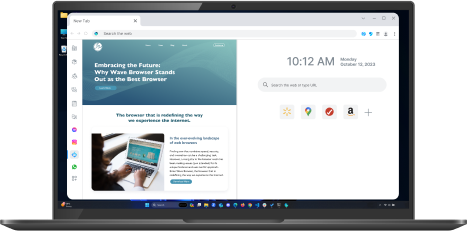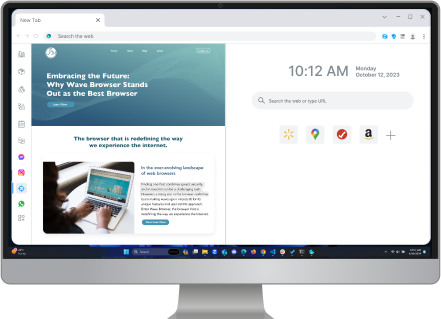How to Stay Safe While Browsing Online
Table of Contents

In today's internet-driven world, ensuring your child's online safety and safe web browsing on a secure browser has never been more crucial. Growing up with technology, children are likely to make common internet privacy mistakes. With the vast expanse of important information, interactive online activities, and social connections, it's more crucial than ever for parents to take an active role in ensuring their children practice safe browsing habits online with the most secure browser. In this guide, we'll explore the fundamentals of digital citizenship, understand the potential threats your children browsing online may encounter, learn how to set up safe website browsing safeguards to protect children’s online security, educate them about safe browsing online habits with a secure web browser (like Microsoft Edge or Internet Explorer), and employ tools to create a secure online environment.
How to Practice Safe Browsing Online
Step 1: Understand Internet Risks

To effectively ensure your child's safe browsing online, you need the most secure web browser (like Wave Browser or Avast Secure Browser) and of equal importance, you need to be aware of the potential dangers they might face.
Cyberbullying, identity theft, malware, exposure to inappropriate and dangerous website content, and contact with online predators are just a few of the risks your children face, even on the best secure browser. Stay informed by referring to resources from trusted institutions such as the National Center for Missing & Exploited Children and the FBI.
Step 2: Cyberbullying Prevention and Reporting Cyberbullies

In the mission to protect our children online, preventing cyberbullying is a top priority. This harmful behavior occurs on even the most secure internet browser with platforms like social media, messaging apps, and gaming sites, impacting kids' well-being. To ensure their safety:
- Guard Personal Info: Teach kids not to share sensitive details like name, school, or address online.
- Approach Interactions Carefully: Advise caution when interacting with strangers online and discourage sharing personal info.
- Report Cyberbullying: Empower kids to report any cyberbullying incidents to trusted adults or platform administrators.
By fostering these habits and using the best secure web browser, we create a secure digital environment where children can thrive and grow without the fear of cyberbullying.
Step 3: Set Up Strong Safeguards and Malware Protections

Shielding your child from online threats starts with implementing the right safeguards:
- Parental Controls: Utilize parental control apps and software to manage online activity and limit exposure to inappropriate content.
- Privacy Settings: Educate your child about the importance of privacy settings on social media sites and apps. Instruct them to restrict access to their personal data and posts to trusted friends. You might also consider adding browser extensions for increased privacy protection.
- Internet Filters: Enable internet filters provided by your internet service provider (ISP) to block potentially harmful websites and content based on your IP address.
You can also enable a UTM network device that includes antivirus, content filtering, email and web filtering, and anti-spam
Step 4: Get to Know Google Chrome Browser's Parental Controls:

If Chrome is your default browser, Google's Security features center offers parental control features through its "Family Link" platform, which is designed to help parents manage and monitor their children's online activity across supported devices and supported operating systems, such as smartphones and tablets.
Here are some key features and functionalities of Google's Family Link parental controls:
- Create and Manage Google Accounts: Parents can create a Google account for their children and manage those accounts through their own Google account.
- App Management: With Family Link, parents can review and approve the apps their child wants to download from the Google Play Store.
- Screen Time Limits: Parents can set daily usage limits for various apps and devices.
- Bedtime and Downtime: Lets parents set specific bedtime hours, during which the child's device will be locked and when specific apps are not accessible.
- Activity Reports: Parents receive weekly or monthly activity reports detailing their child's app usage and screen time.
- Location Tracking: These trackers enable parents to track their child's device location and monitor where their child is throughout the day.
- Safe Search: Safe Search settings can be enabled on Google Search to filter out explicit content and ensure a safer online search experience for children.
- Content Filters: Allows parents to filter and block inappropriate content on Google Chrome.
- Device Locking: In case of lost or misplaced devices, parents can remotely lock their child's device to protect personal data.
- Gradual Independence: Gives parents the option to transition from strict supervision to a more independent online experience as children grow.
Interland - Google's Internet Safety Game for Children

Interland is a free online game created by Google assistive technology that teaches children how to stay safe while web browsing. The game takes players through various scenarios where they must identify phishing scams, protect their personal information, and avoid cyberbullies. By playing Interland, children can learn valuable skills that will help them navigate the internet safely and confidently.
Step 5: Teach Safety Basics to Children Browsing Online

Empower your child with the basics of online safety:
- Safe Browsing: Educate your child about the significance of using safe browsers, private browsing, and secure websites with "https" in the browser's address bar, especially when sharing personal information.
- Recognize Phishing: Teach your child to identify phishing attempts that trick users into revealing sensitive data via email or instant messaging.
Smart Password Practices: Instill the importance of creating a unique, strong password, and avoiding sharing them, while managing them on Google’s Password Manager.
Step 6: Open Communication to Promote Children Online Security

Create an environment of open communication:
- Encourage Openness: Let your child know they can always approach you with their online experiences, both positive and negative.
- Be a Trusted Adult: Establish yourself as a trusted adult who can provide guidance when your child encounters unfamiliar situations online.
Step 7: Navigate Social Media Safely

Ensure your child's safety on social media platforms:
- Guidelines for Social Media Apps: Establish rules for using social media apps, including accepting friend requests only from people they know in real life.
- Identity Protection: Advise your child to avoid sharing personal information like their full name, school, address, phone number, or other identifiable data on public forums.
Step 8: Monitor Online Activities and Smartphone App Use

Stay actively engaged in your child's online activities:
- Know Their Apps: Familiarize yourself with the apps and online games your child uses. Discuss the features and potential risks associated with each.
- Explore Together: Spend time with your child exploring educational online platforms like Google's "Interland," designed to teach internet safety and responsible online behavior.
Step 9: Stay Updated

With new apps and online risks emerging regularly, it is important to keep up-to-date with the latest trends and safety measures to provide effective guidance to maintain safe browsing practices for children. Of course, there's only so much parents can do to ensure safe browsing online experiences for their children. It's also a good idea to be familiar with the laws that exist to protect children's online safety.
Children's Online Privacy Protection Act Violations

The Children's Online Privacy Protection Act (COPPA) is a law that safeguards the privacy of children under 13 online. Websites and apps must get parental consent before collecting personal information from kids, as they have a legal right to more private browsing. Violations include collecting data without consent, misleading practices, and weak parental verification. Consequences can include fines up to $43,280 per violation, legal action, reputation damage, and loss of trust.
What is the FBI's Role in Protecting Children's Online Safety?

The FBI plays a critical role in ensuring children's online safety. It focuses on identifying and apprehending online predators who exploit and harm children. Investigations target cases of child exploitation, including child pornography and trafficking. By partnering with law enforcement agencies the FBI combats online crimes against children effectively.
If you suspect your child is a victim of online exploitation do not hesitate to report it. Depending on the severity, you have a few reporting options:
- Local Law Enforcement: If the situation poses immediate danger, contact your local law enforcement agency.
- National Center for Missing & Exploited Children (NCMEC): Report the incident to NCMCE through their CyberTipline at 1-800-THE-LOST (1-800-843-5678) or online at https://cybertip.org/
- Online Platforms: If the exploitation is occurring on a specific platform, report the user and their activities to the platform administrators.
Secure Online Safety for Children
By implementing safe browsers, the necessary parental controls, engaging in open communication about internet safety practices with your children, and knowing who to seek help from in case of emergencies, you can help your child build a strong foundation in online safety. Remember, the internet can be a remarkable educational tool when approached with caution and guidance. So follow these instructions carefully and don’t forget the importance of using only secure browsers, like Tor Browser or Wave Browser. Get your free secure browser download today from Wave Browser for a safer, more secure browsing experience with a built-in ad blocker.
Surf with Ease, Speed, and Security!

Download Wave Browser for a seamless online experience like never before. Try it now!



























